G1 exam study guide Study guides, Class notes & Summaries
Looking for the best study guides, study notes and summaries about G1 exam study guide? On this page you'll find 76 study documents about G1 exam study guide.
Page 3 out of 76 results
Sort by
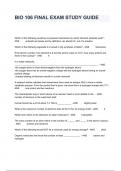
-
BIO 106 FINAL EXAM STUDY GUIDE Questions With Correct Answers
- Exam (elaborations) • 15 pages • 2024
-
- $11.89
- + learn more
BIO 106 FINAL EXAM STUDY GUIDE Which of the following would be a proposed mechanism by which stomach antacids work? - ANS antacids are bases and by definition can absorb H+ out of a solution Which of the following organelle is involved in the synthesis of lipids? - ANS ribosomes If the atomic number of an element is 6 and the atomic mass is 12.01, how many protons are there in the nucleus? - ANS 6 In a water molecule, _______________________________...

-
AP Biology Unit 5 Study Guide with Complete Solutions
- Exam (elaborations) • 8 pages • 2024
- Available in package deal
-
- $9.99
- + learn more
AP Biology Unit 5 Study Guide with Complete Solutions Genome - Answer️️ -The genetic material of an organism or virus Chromosomes - Answer️️ -structures made of one DNA molecule and proteins Somatic Cells - Answer️️ -body cells Gametes - Answer️️ -reproductive cells Chromatin - Answer️️ -The complex of DNA and proteins that makes up eukaryotic chromosomes. Centromere - Answer️️ -Point on a chromosome by which it is attached to a spindle fiber during cell division...
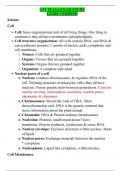
-
ATI TEAS 6 EXAM STUDY GUIDE VERIFIED
- Exam (elaborations) • 30 pages • 2023
-
- $9.99
- + learn more
ATI TEAS 6 EXAM STUDY GUIDE VERIFIED Science Cell Cell: basic organizational unit of all living things. One thing in common is they all have membranes (phospholipids). Cell structure organization: All cells contain DNA, and RNA & can synthesize proteins. Consists of nucleic acids, cytoplasm, and cell membrane. o Tissues: Cells that are grouped together o Organs: Tissues that are grouped together o Systems: Organs that are grouped together o Organism: A complete individual Nuclear par...

-
ATI TEAS 6 EXAM STUDY GUIDE Science:Cell
- Exam (elaborations) • 29 pages • 2023
-
- $13.49
- + learn more
ATI TEAS 6 EXAM STUDY GUIDE Science Cell September 9 -13 2020 ATI TEAS 6 EXAM STUDY GUIDE Science Cell Cell: basic organizational unit of all living things. One thing in common is they all have membranes (phospholipids). Cell structure organization: All cells contain DNA, and RNA & can synthesize proteins. Consists of nucleic acids, cytoplasm, and cell membrane. o Tissues: Cells that are grouped together o Organs: Tissues that ar...
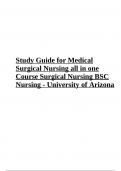
-
Study Guide for Medical Surgical Nursing all in one Course Surgical Nursing BSC Nursing - University of Arizona
- Exam (elaborations) • 700 pages • 2023
-
- $32.49
- + learn more
Study Guide for Medical Surgical Nursing all in one Course Surgical Nursing BSC Nursing - University of Arizona. Infection and Human Immunodeficiency Virus Infection 1. To what is the increase in emerging and untreatable infections attributed (select all that apply)? a. Global travel and bioterrorism b. The evolution of infectious agents c. Use of antibiotics to treat viral infections d. Transmission of infectious agents from humans to animals e. An increased number of immunosuppressed an...
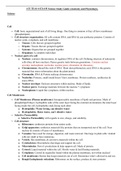
-
ati teas 6 exam science study guide anatomy and physiology
- Exam (elaborations) • 18 pages • 2023
-
Available in package deal
-
- $20.49
- + learn more
ATI TEAS 6 EXAM S cience Study Guide (Anatomy and Physiology). Science Cell Cell: basic organizational unit of all living things. One thing in common is they all have membranes (phospholipids). Cell structure organization: All cells contain DNA, and RNA & can synthesize proteins. Consists of nucleic acids, cytoplasm, and cell membrane. o Tissues: Cells that are grouped together o Organs: Tissues that are grouped together o Systems: Organs that are grouped together o Organism: A...
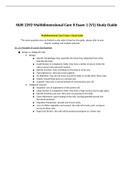
-
NUR 2392 Multidimensional Care II Exam 1 (V1) Study Guide
- Exam (elaborations) • 31 pages • 2022
-
- $13.99
- + learn more
NUR 2392 Multidimensional Care II Exam 1 (V1) Study Guide Multidimensional Care II Exam 1 Study Guide *The exam questions are not limited to only what is listed on this guide, please refer to your chapter readings and module materials Ch. 21: Principles of Cancer Development ● Benign vs. Malignant cells ○ Benign: ■ Specific Morphology- they resemble the tissue they originated from (they look like the host). ■ Small Nuclear to Cytoplasmic Ratio- they have a similar structure in...
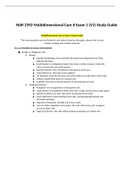
-
NUR 2392 Multidimensional Care II Exam 1 (V1) Study Guide
- Exam (elaborations) • 31 pages • 2022
-
- $13.99
- + learn more
NUR 2392 Multidimensional Care II Exam 1 (V1) Study Guide Multidimensional Care II Exam 1 Study Guide *The exam questions are not limited to only what is listed on this guide, please refer to your chapter readings and module materials Ch. 21: Principles of Cancer Development ● Benign vs. Malignant cells ○ Benign: ■ Specific Morphology- they resemble the tissue they originated from (they look like the host). ■ Small Nuclear to Cytoplasmic Ratio- they have a similar structure in...
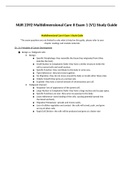
-
NUR 2392 Multidimensional Care II Exam 1 (V1) Study Guide
- Exam (elaborations) • 31 pages • 2022
-
- $13.99
- + learn more
NUR 2392 Multidimensional Care II Exam 1 (V1) Study Guide Multidimensional Care II Exam 1 Study Guide *The exam questions are not limited to only what is listed on this guide, please refer to your chapter readings and module materials Ch. 21: Principles of Cancer Development ● Benign vs. Malignant cells ○ Benign: ■ Specific Morphology- they resemble the tissue they originated from (they look like the host). ■ Small Nuclear to Cytoplasmic Ratio- they have a similar structure in...
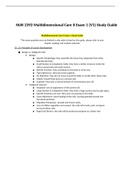
-
NUR 2392 Multidimensional Care II Exam 1 (V1) Study Guide
- Exam (elaborations) • 31 pages • 2022
-
- $13.99
- + learn more
NUR 2392 Multidimensional Care II Exam 1 (V1) Study Guide Multidimensional Care II Exam 1 Study Guide *The exam questions are not limited to only what is listed on this guide, please refer to your chapter readings and module materials Ch. 21: Principles of Cancer Development ● Benign vs. Malignant cells ○ Benign: ■ Specific Morphology- they resemble the tissue they originated from (they look like the host). ■ Small Nuclear to Cytoplasmic Ratio- they have a similar structure in...

Do you wonder why so many students wear nice clothes, have money to spare and enjoy tons of free time? Well, they sell on Stuvia! Imagine your study notes being downloaded a dozen times for $15 each. Every. Single. Day. Discover all about earning on Stuvia


